

建筑、室内、景观设计单位 line+建筑事务所
合作单位 西城工程设计集团有限公司
项目地点 浙江丽水
建成时间 2024年3月
建筑面积 地上13738.96平方米,地下6463.65平方米
本文文字由line+提供。
“与设计一座纯粹、清冷的艺术中心相比,我更希望丽水古堰画乡艺术中心是多元、热闹的,白天能看展逛街,傍晚能散步玩耍,晚上有市集、聚会、广场舞。悬浮的超尺度带来标识性,底层散落的小盒体又有烟火气息,艺术和市井相互滋养,融合共生,实现真正共享的日常性空间。”
"In contrast to designing a pure and austere art center, I envision the Lishui Guyanhuaxiang Art Center as a vibrant and diverse space. During the day, visitors can explore exhibitions, while in the evening, they can stroll, gatherings, and square dances. The iconic suspended structure brings visibility, while the scattered small box-like structures on the ground exude a lively atmosphere. Art and everyday life nourish each other, merging into a symbiotic relationship, achieving a truly shared space for daily activities."
——孟凡浩
— Meng Fanhao
由line+联合创始人、主持建筑师孟凡浩率领建筑、室内、景观一体化团队设计完成的丽水古堰画乡艺术中心,于2024年4月28日正式开馆,投入使用。作为丽水市规模最大的艺术综合体,古堰画乡艺术中心将成为当地重要的文化艺术展览活动平台,并进一步健全完善古堰画乡小镇景区的公共文化设施网络,切实以艺术融合文旅推动城镇发展。
The Zhejiang Lishui Guyanhuaxiang Art Center was designed by Meng Fanhao, Co-Founder and Chief Architect of line+ studio, leading an integrated team of architects, interior designers, and landscape architects. The project officially opened to the public on April 28, 2024. As the largest art complex in LiShui city, the Art Center is poised to become a pivotal hub for cultural exhibitions and activities, enriching the public cultural infrastructure of the scenic area. It aims to foster urban development by integrating art and tourism seamlessly.

浙江丽水莲都古堰画乡小镇,因1500年历史的世界遗产“通济堰”和“丽水巴比松画派诞生地”而得名。“古堰”“画乡”隔水相望,孕育出了这座古韵诗意与现当代艺术共生的特色小镇,并逐步形成了集艺术画廊、艺术教育、古镇文旅、居民生活于一体的生态系统,2019年被授予“浙江省第三批省级特色小镇”。
Zhejiang Lishui Liandu Guyan Huaxiang Ancient Town, named after the 1500-year-old world heritage site "Tongji Canal (Guyan)" and the birthplace of the "Lishui Barbizon School of Painting (Huaxiang)," sits across the water from "Ancient Canal" and "Artistic Village." This town, nurtured by its ancient charm and the coexistence of modern art, has gradually developed into a unique ecological system integrating art galleries, art education, cultural tourism, and residential life. In 2019, it was honored with the title of "Zhejiang Province's Third Batch of Provincial-level Characteristic Towns."

2020年,当地政府计划在小镇核心区建设一座艺术中心,满足当地居民、游客、艺术师生日益增长的需求,同时兼具艺术展览和公共教育等功能,未来也将作为小镇文化展示的重要平台和地标性建筑。
In 2020, the local government planned to construct an art center in the core area of the town to meet the growing needs of local residents, tourists, artists, and students. This center would serve both as an art exhibition space and a venue for public education. Additionally, it was envisioned to become a significant platform for showcasing the town's culture and a landmark building in the future.
艺术中心坐落于高密度的老居民区中,与保留着传统聚落形态的古街近在咫尺,四周群山环绕,北面紧邻瓯江大溪段,充满原生态的市井烟火气。
The art center is nestled in a densely populated old residential area, with the traditional settlement forms of the ancient streets nearby. Surrounded by mountains, it sits close to the Ou River's Daxi section to the north, exuding an authentic atmosphere of local life.

在前期调研和策划阶段,我们意识到通常作为“舞台”的艺术公共建筑,在这座小镇中,其机构性和公共性被解构为一种新的并置关系——艺术中心与小镇生活将互为背景。另一方面,从艺术空间的运营角度来看,仅仅依赖小镇已具备的艺术产业基础作为展览内容,不足以支撑如此大体量的艺术中心的长久运营。
During the initial research and planning stages, we realized that the typical "stage" role of art public buildings, in this town, its institutional and public nature are deconstructed into a new juxtaposition—where the art center and town life become mutually backgrounded. On the other hand, from the perspective of art space operation, relying solely on the existing artistic industry foundation of the town for exhibition content is insufficient to sustain the long-term operation of such a large-scale art center.

所以在任务书阶段,我们就提出运营前置的思维,与业主讨论项目定位、后续可持续运营模式并一起制定设计任务书,确保项目建成后能成为高坪效公共空间。通过将小镇的日常活动纳入其中,在时间和空间上拓展艺术中心的其他可能性,以集合未来商业、文化活动、娱乐休闲、艺术策展、培训教育等混合业态和复合场景,来激发空间活力。
Therefore, during the briefing stage, we proposed a proactive approach to operations and discussed project positioning and sustainable operating models with the client. Together, we formulated the design brief to ensure that the project would become a high-efficiency public space. By incorporating the daily activities of the town and expanding the possibilities of the art center in terms of time and space, we aimed to stimulate spatial vitality by integrating various mixed-use formats and composite scenarios, including future commercial, cultural, entertainment, leisure, art curation, and educational activities.


基于此,艺术中心明确了其两大主体,一是作为现当代艺术的展示空间,二是作为小镇居民的日常活动空间。艺术中心的设计通过艺术机构的职能性、公共空间延伸、复合化功能、地域性表达四个方面展开,在抽象的现当代艺术和生动的小镇日常生活之间构建并置和交融的关系——并置主要体现在体量和材质表现的对话关系上,交融则是空间与时间维度上的场景重叠。
Based on this, the art center has clarified its two main aspects: one is as a space for displaying contemporary art, and the other is as a space for the daily activities of town residents. The design of the art center unfolds through four aspects: functional nature of artistic institutions, extension of public spaces, diversified functions, and regional expression. It seeks to establish a relationship of juxtaposition and integration between abstract contemporary art and vibrant daily life in the town. Juxtaposition is primarily reflected in the dialogue between volume and material expression, while integration occurs through the overlap of spatial and temporal dimensions.


如何平衡艺术中心的机构性和公共性,以及如何处理艺术中心与居住区、山水环境等周边环境的对话关系,塑造建筑成为小镇的新地标,成为建筑形体设计的两大目标。项目占地13129.92平方米,容积率1.05,地上空间体量共计1.3万平方米。
Balancing the institutional and public aspects of the art center, as well as managing its dialogue with the surrounding residential areas and natural landscape, are crucial for shaping the building into a new landmark for the town. With a site area of 13,129.92 square meters and a floor area ratio of 1.05, the project aims to achieve these two main objectives through its architectural design.

出于艺术中心整体容量,以及展厅连贯的流线组织与交通疏散的考虑,建筑采取了整体大尺度巨构、局部小尺度体块的形体策略,既消解了对街区的压迫感,又可以承载多元的功能业态。
To address the need for coherent circulation and efficient traffic evacuation within the art center, the architecture adopts a strategy of large-scale overall structures complemented by smaller-scale elements. This approach not only alleviates the sense of oppression within the block but also accommodates diverse functional formats.


建筑尽可能贴临场地红线布局,守住老街边界的同时保持街巷的连续与完整;内侧围合出一大一小两个庭院;进而通过边界退让与角部抬升,呈开放姿态。建筑上部以超日常的巨构尺度容纳艺术展陈功能,连续一体且不规则起伏的悬浮形态,与远山遥相呼应,与周边民居相区别。建筑底部则构建了贴近日常的街区尺度,小盒子空间错落布置,用于承载不同的零售及休闲功能。至此,艺术中心的机构性与公共性形成了上下的并置。
The building is laid out as close to the site's red line boundary as possible, maintaining the integrity of the old street boundaries while ensuring the continuity and integrity of the streets and alleys. Two courtyards are enclosed on the inner side, one large and one small, and the building adopts an open posture through boundary setbacks and corner elevations. The upper part of the building accommodates art exhibition functions with a super-normal large-scale structure, featuring a continuous and irregular suspended form that echoes the distant mountains and distinguishes itself from the surrounding residential areas. The lower part of the building is designed to fit the daily scale of the neighborhood, with small box spaces arranged in a staggered manner to accommodate various retail and leisure functions. Thus, the institutional and public aspects of the art center are juxtaposed vertically.



小镇艺术中心的公共性不仅在于其开放的场所环境,更重要的是与小镇居民的日常生活直接关联,邀请居民成为空间的主体。因此,我们将作为小镇公共活动的重要载体——广场和街区原型纳入建筑设计,并通过三条路径得以实现。
The public nature of the town's art center lies not only in its open physical environment but also in its direct connection to the daily lives of the town residents, inviting them to be the main participants in the space. Therefore, we incorporate the prototypes of the square and the block, which serve as important carriers of public activities in the town, into the architectural design, and this is realized through three strategies.

其一,朝向老街与小镇方向的三个街角,通过边界退让与角部抬升,形成三处较大尺度的街角广场与底层架空空间,引导街巷人群步入建筑。
Firstly, at the three street corners facing the old street and the direction of the town, we create three larger-scale street corner squares and ground-level elevated spaces by retreating the boundaries and elevating the corners. This design encourages people from the streets and alleys to enter the building.



其二,艺术中心的首层,来源于对场地周边空间肌理的重组,使得场地与周边街巷贯通连续。多个民居尺度的商业体量,通过旋转、穿插、进退,与周边低矮的民宅围合出尺度适宜的街巷空间,使建筑形体由此在近人尺度上化整为零,延续场地记忆。
The ground floor of the art center is derived from the reorganization of the spatial texture surrounding the site, allowing for seamless integration with the surrounding streets and alleys. Multiple commercial volumes of residential scale, through rotation, insertion, advancement, and retreat, enclose appropriately scaled street spaces with the low-rise residential houses nearby, allowing the architectural form to be broken down into human scale, thus extending the memory of the site.







其三,围合的空间内部,在建筑二层设置架空的连廊,以此打破大空间的单一性。尺度不一的庭院广场丰富了艺术中心面向日常的公共属性:大广场提供小镇千人集会的场所;小庭院则以保留的百年古树为中心,延续乡镇中依附大树而存在的寻常公共空间。
The enclosed spaces inside the complex feature elevated walkways on the second floor, breaking the monotony of the large spaces. Various-sized courtyard squares enrich the art center's public nature: the large square serves as a venue for town gatherings, while the small courtyard, centered around century-old trees, continues the tradition of communal spaces found in towns, often centered around large trees.






悬浮于小镇生活之上的展陈空间,由大小不同的展厅、连廊串联而成,并具有完整连贯的空间流线。顺应建筑形态起伏,形成“起承转合”的观展叙事,也为策展者提供一种独特的策展视角。
The exhibition space, suspended above the town life, is composed of interconnected galleries and corridors of varying sizes, forming a coherent spatial flow. Following the undulating architectural form, it creates a narrative of "exposition, development, climax, and conclusion" for the exhibition, providing curators with a unique perspective for curation.









观展路径以街巷广场为起点,穿过底层架空空间与庭院进入艺术中心,走过平缓的台阶式展厅、长坡道、悬空连桥,经由展览空间抵达屋顶。透明性与半透明性的材质介入,使得艺术观展体验与日常生活的场景穿插交融,或冲突,或惊喜,形成独特的经验记忆。
The exhibition circulation begins at the street and plaza, leading through the ground-level open space and courtyards into the art center. Visitors traverse gentle steps, sloping ramps, and suspended bridges, passing through exhibition spaces to reach the rooftop. Incorporating materials with transparency and translucency, the experience of art viewing intertwines with scenes of daily life, creating unique and memorable encounters that blend conflict with surprise.




在整体为素色的展览空间室内,由与建筑相同的红色金属锈板楼梯为统领,贯穿其中,打破了通常封闭美术馆的白盒子印象,使得内外空间得以连贯,也丰富了内部空间的体验。
In the predominantly monochromatic exhibition space interior, the unifying element is the red metal rusted staircase, echoing the architectural features, piercing through it. This breaks away from the typical enclosed "white box" impression of art galleries, allowing for seamless integration between interior and exterior spaces, enriching the internal spatial experience.


建筑的结构难点在于其不规则的大尺度外挑形式,材料难点在于不同尺度空间的场所暗示与对话关系。
The architectural challenge lies in its irregular large-scale cantilevered form, while the material challenge lies in the spatial implications and dialogue between spaces of different scales.


钢结构
为实现将周边人流引入场地,使艺术中心成为日常活动发生的场所,建筑有多处大悬挑和抬升,从施工可行性和造价成本的角度考虑,最终确定建筑地上部分采用钢结构,大跨和抬升区域采用桁架的结构形式。
To attract pedestrian flow from the surrounding area and make the art center a venue for daily activities, the building features several large cantilevers and elevations. Considering construction feasibility and cost-effectiveness, it was decided to use a steel structure for the upper part of the building, with trusses employed in areas with large spans and elevations.







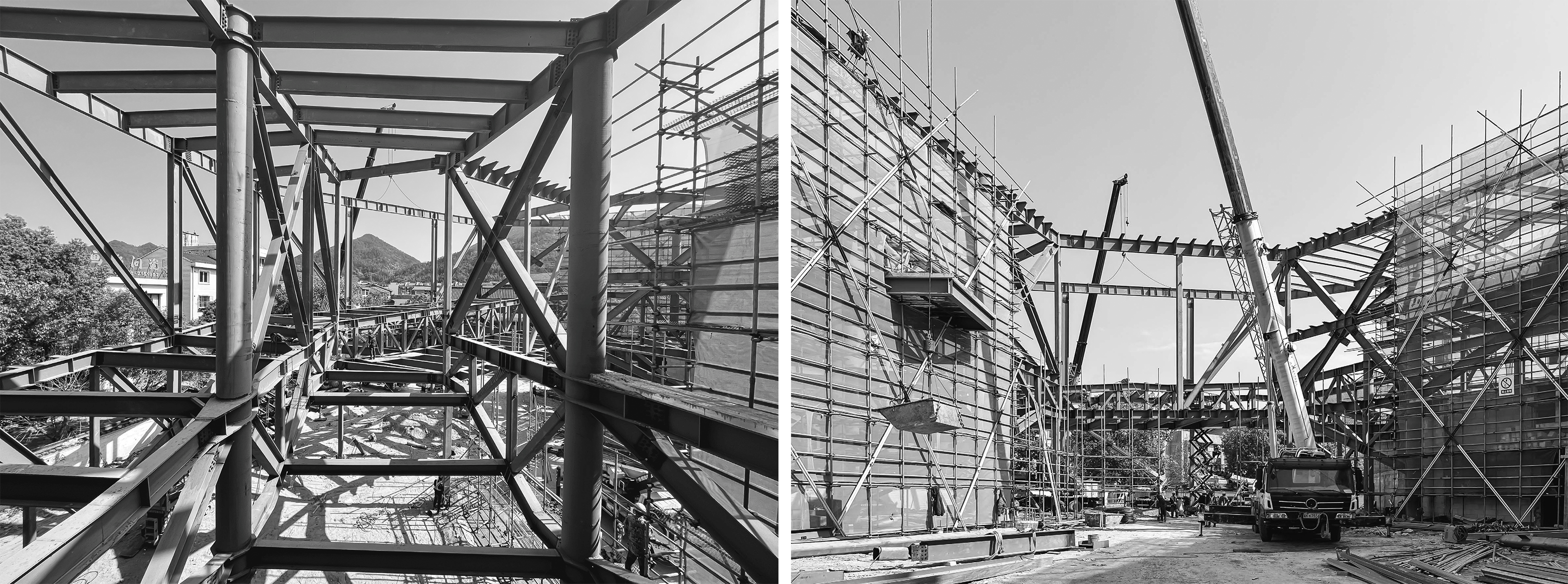
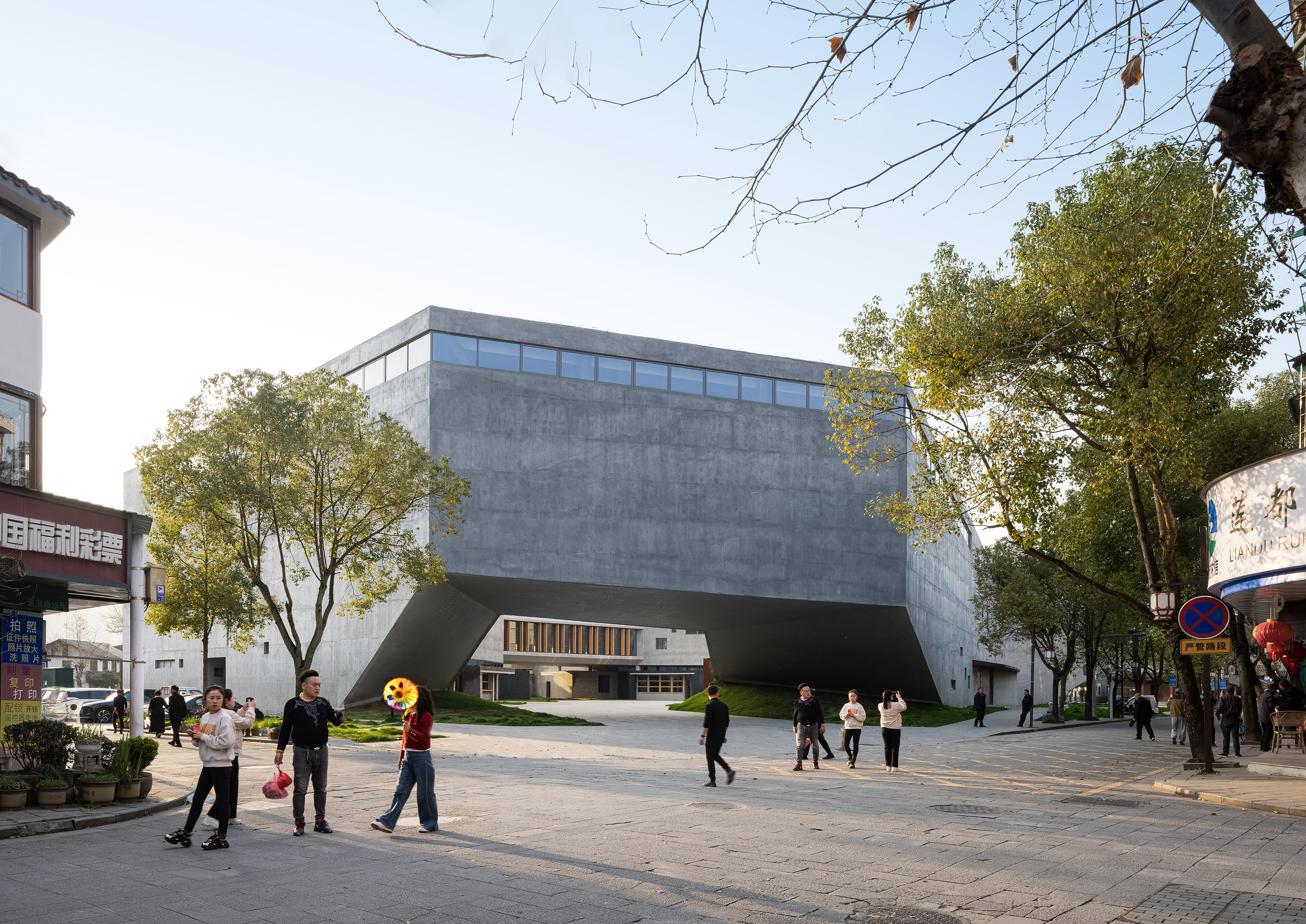



门厅上方有多个方向联通的连桥,将观展人流引上屋顶平台,为使空中连桥显得轻盈,结构采用吊杆的形式,将连桥悬吊在屋面梁上。
Above the lobby, there are multiple skybridges connecting in various directions, guiding visitors to the rooftop platform. To create a sense of lightness for the skybridges, they are suspended from the roof beams using cable rods.



混凝土
外立面主材选用木模板混凝土,其色调温和而肌理质朴,可以柔化大尺度建筑的压迫感,呈现素雅的气质,并与原生的小镇环境形成柔和的新旧对话。
The main material for the exterior facade is board-formed concrete, known for its warm tones and textured surface, which can soften the imposing scale of the building and present an elegant ambiance. It fosters a gentle dialogue between the contemporary architecture and the vernacular surroundings of the old town.

由于现浇混凝土将会导致建筑主体自重较重,对结构产生极大负担,进而影响到建筑的使用空间以及项目整体造价,因此我们放弃了现浇混凝土方案,而改用装饰混凝土+加气混凝土砌块组成的外维护结构。加气混凝土砌块单位质量仅有现浇混凝土的1/4至1/5,减轻结构风险的同时有效控制结构造价。整体也能够实现混凝土朴素自然的质感和真实的粗犷特质。
Due to the heavy weight of cast-in-place concrete, which would impose significant loads on the structure and affect the usable space and overall cost of the project, we opted for a facade structure composed of decorative concrete and aerated concrete blocks instead. Aerated concrete blocks weigh only 1/4 to 1/5 of cast-in-place concrete per unit, reducing structural risks while effectively controlling construction costs. This approach allows us to achieve the natural and rugged qualities of concrete while ensuring a lighter overall structure.

外立面采用的50毫米厚度薄浇的木模板混凝土,其混凝土模板是可重复利用的橡胶+胶合板的复合模板。在整体混凝土墙面浇筑完成后,每隔6米切割出一道明缝,最终再用砂浆填充修复,使得竖向明缝和横向禅缝做到一致,保证立面的连续性。
The façade utilizes a 50mm thick thinly poured wooden formwork concrete, with reusable rubber and plywood composite formwork for the concrete molds. After the overall concrete wall is poured, a visible seam is cut every 6 meters, which is later filled and repaired with mortar to ensure consistency between vertical and horizontal joints, maintaining the continuity of the façade.





底层商业盒子
艺术中心首层功能主要以商铺为主,高低错落的小盒子在尺度、形式、材料上均与古镇相呼应,为延续古镇老房子的材料肌理,我们使用青砖、小青瓦以及耐候钢板,化解上部大尺度混凝土的冷酷感,为近人尺度提供更多的色彩和温度。
The primary function of the ground floor is commercial space, with small boxes arranged in a staggered manner in terms of scale, form, and material, echoing the characteristics of the ancient town. To continue the material texture of the old houses in the ancient town, we use blue bricks, small green tiles, and weather-resistant steel plates. This approach helps to soften the coldness of the large-scale concrete structure above and provides more color and warmth at the human scale.


通过提取周边原有的村落肌理,我们将首层小尺度的商业体量与场地铺装的精心设计进行打散重组,以延续场地空间的场所记忆。在铺装材料的选择上,延续底层商业盒子的立面肌理,将砖、瓦用到地面铺装上,强化场所的领域感。
By extracting the existing village texture from the surroundings, we dispersed and reorganized the small-scale commercial volumes of the ground floor, integrating them with carefully designed paving to extend the spatial memory of the site. In selecting paving materials, we continued the facade texture of the ground-level commercial boxes, incorporating bricks and tiles into the ground paving to enhance the sense of place.


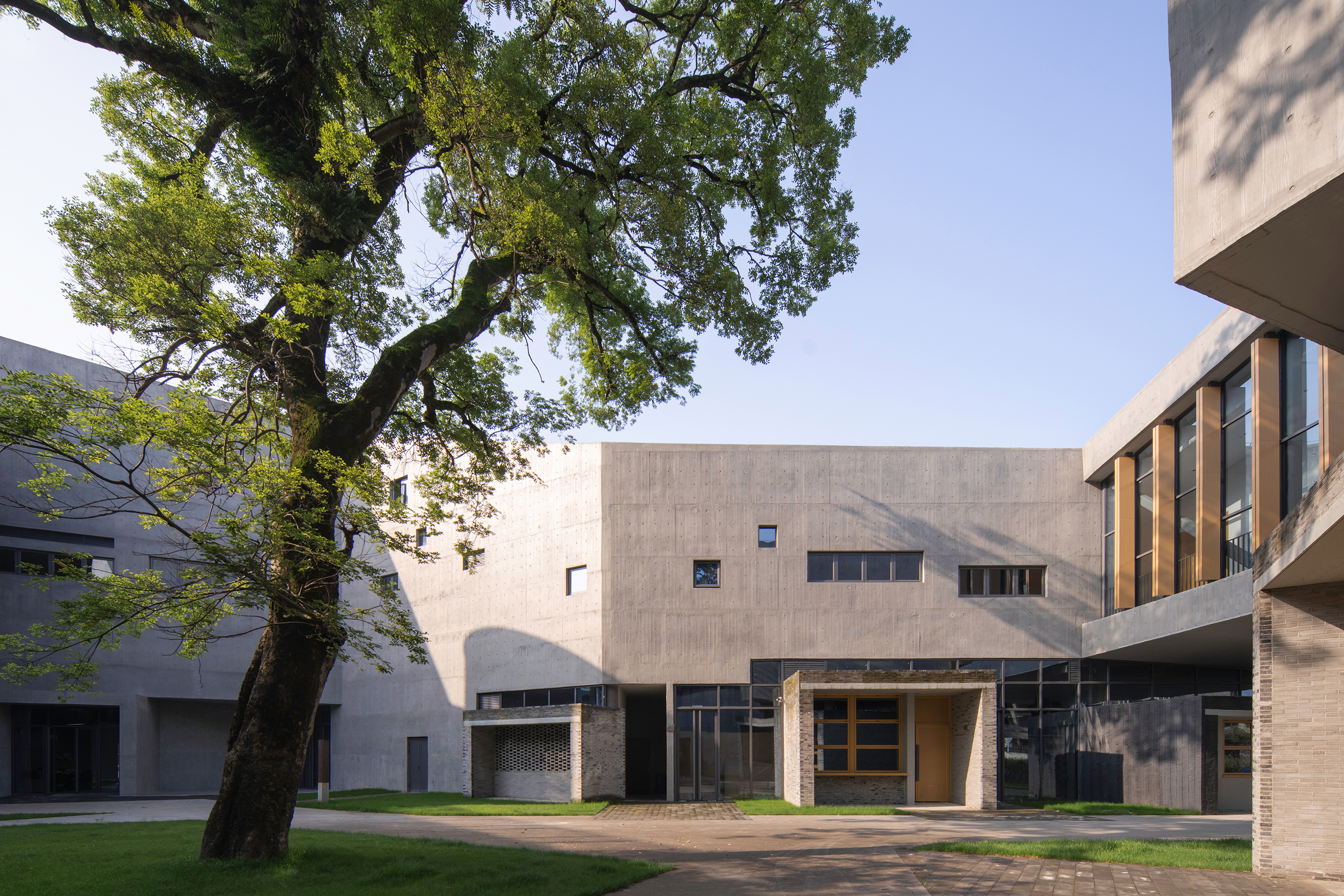
金属格栅
仿木纹铝板形成的竖向构件结合木模板混凝土,保持建筑力量感的同时,增加温润亲切的肌理质感,并在建筑内部形成丰富的光影关系。
The vertical components formed by faux wood grain aluminum panels, combined with wood-molded concrete, maintain the architectural strength while adding a warm and friendly texture. This combination also creates rich light and shadow effects inside the building.

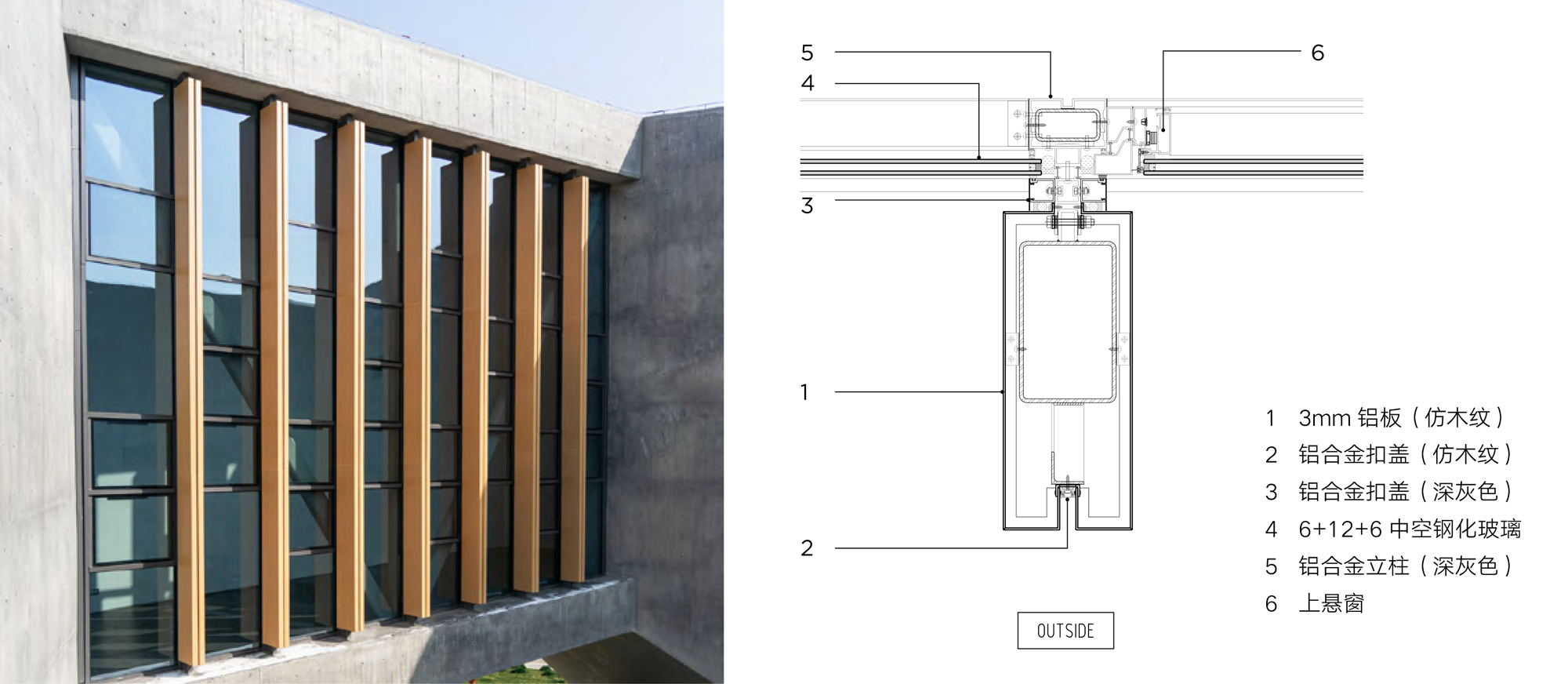
石板瓦屋面
呼应山势高低起伏的屋顶是建筑重要的第五立面,屋面观景平台也是观展体验中的关键环节。出于缓坡屋面的排水需求、观感效果、成本等诸多方面的考虑,我们最终选择了石板瓦,其色彩肌理能很好地融入到古镇的环境中。深浅颜色的瓦片交替铺设,使得屋面整体连续且富有细节变化。
Echoing the undulating terrain, the roof serves as the important fifth facade of the building, and the rooftop viewing platform is a crucial element of the exhibition experience. Considering the drainage requirements, visual effects, cost, and other factors of a sloped roof, we ultimately chose slate tiles. Their color and texture blend seamlessly with the environment of the ancient town. Alternating shades of tiles are laid out to create a continuous yet detailed roofscape.

小镇的独特性在于其鲜活生动的、烟火气十足的生活场景。作为广泛服务于小镇居民而非只针对部分专业人士存在的公共建筑,古堰画乡艺术中心通过让出绝大部分的空间作为小镇活动的延续,通过日常生活的介入将传统的封闭空间变为城市的有机聚合体。
Building an art center for the town is not just about creating a space for art exhibitions; it's about fostering a vibrant community hub that reflects the lively and dynamic scenes of everyday life in the town. Rather than catering exclusively to a niche group of professionals, the Guyanhuaxiang Art Center is designed to serve the broader community, allowing the majority of its space to be utilized for town activities. By integrating daily life into the traditional concept of a closed-off art space, we've transformed it into an organic urban hub.



与其说我们建造了一座具有公共空间的艺术中心,不如说我们建造的是具有艺术展示功能的小镇社区中心,它将容纳商业、文化、培训、教育等多元功能,实现更多维度的价值释放,赋能小镇生活。
In essence, we haven't just built a public space for art; we've constructed a community center with art exhibition capabilities. This center will accommodate various functions such as commerce, culture, training, and education, unlocking multidimensional value and empowering life in the town.

设计图纸 ▽

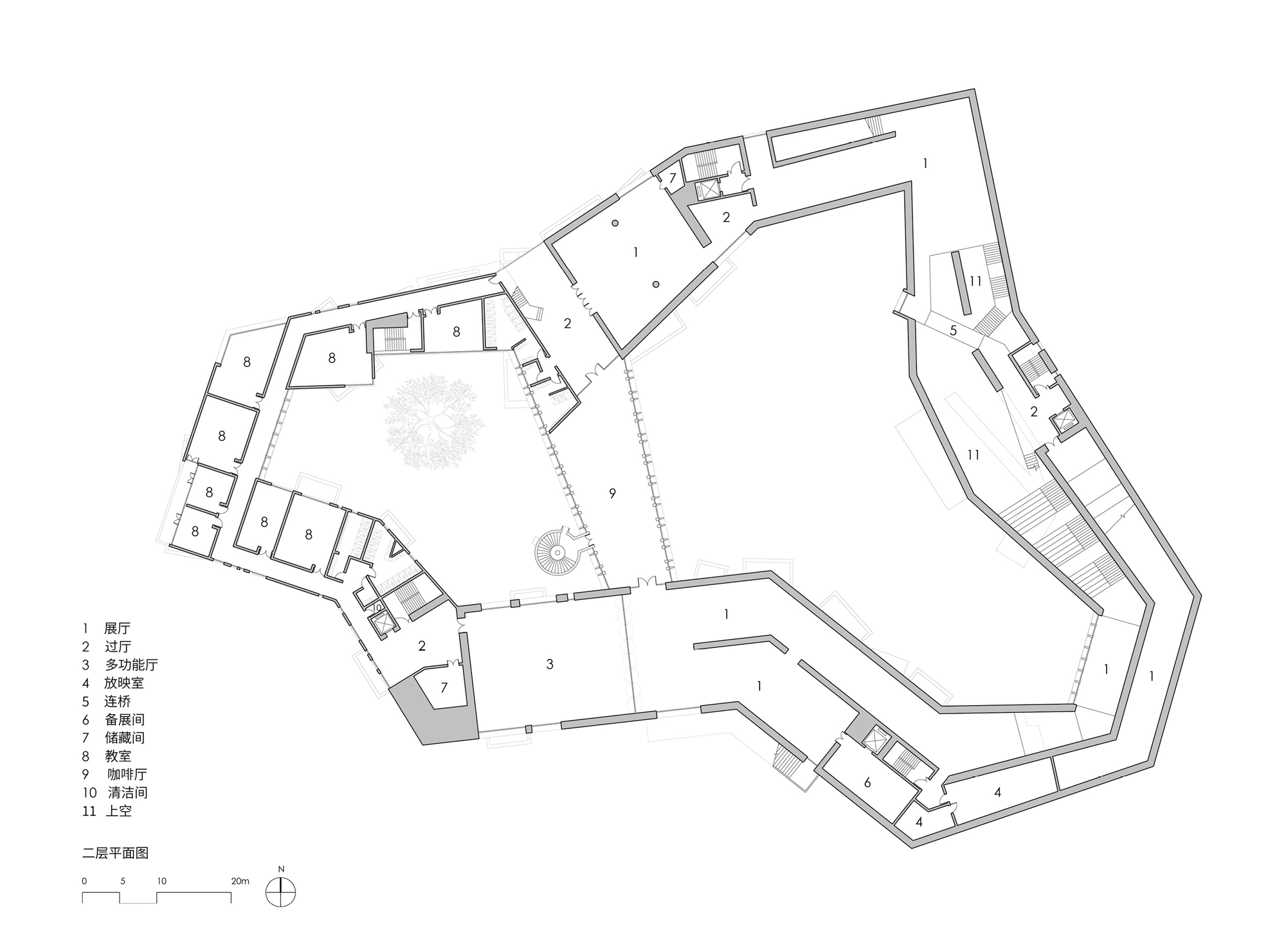
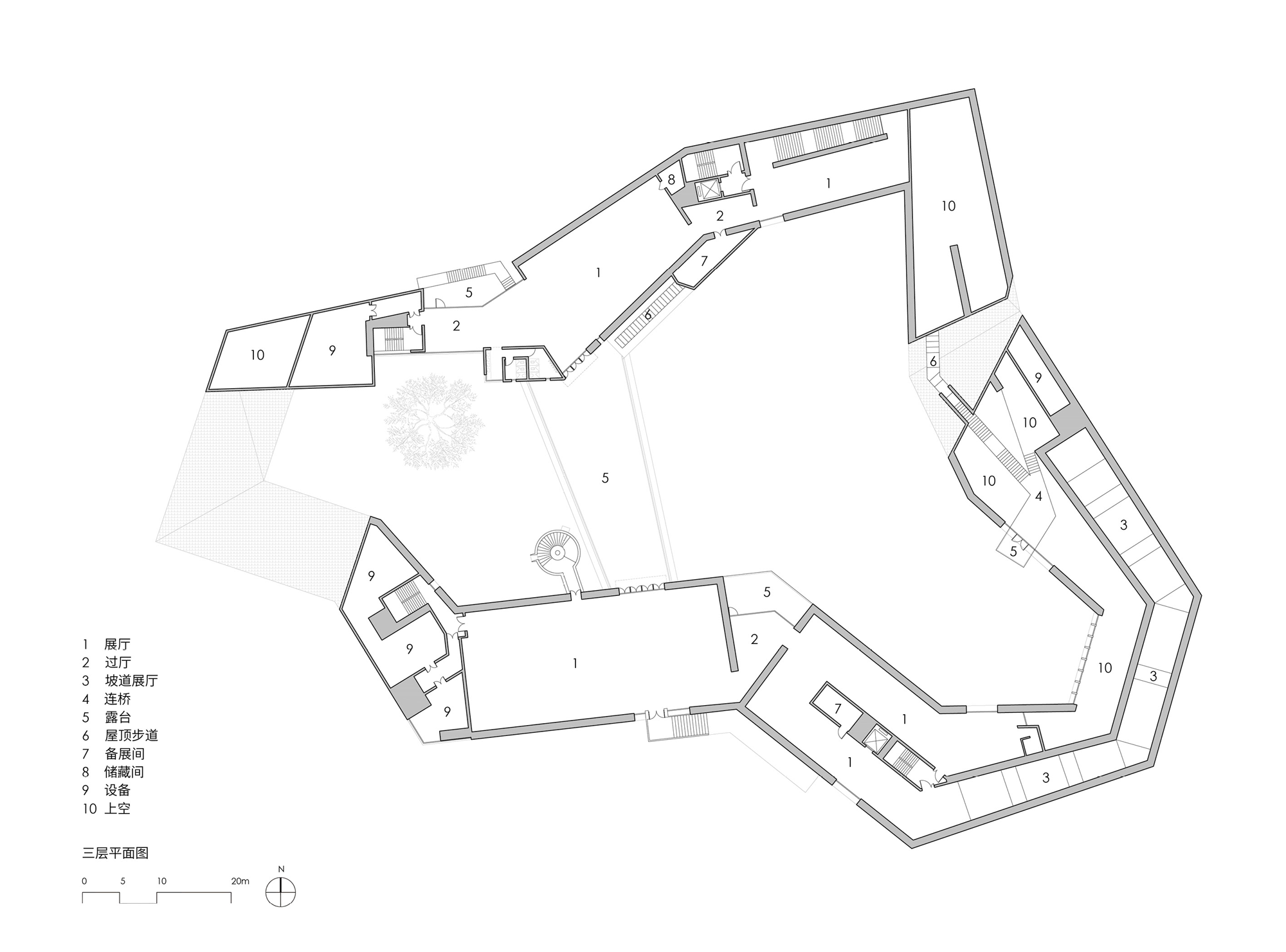



完整项目信息
项目名称:丽水古堰画乡艺术中心
项目地点:浙江省丽水市古堰画乡景区
建筑、室内、景观设计单位:line+建筑事务所
主持建筑师/项目主创:孟凡浩
项目建筑师:李昕光
设计团队:郝军、何雅量、胥昊、万云程(建筑);祝骏、金煜庭、杨莉、梁国庆、张思思、吕斯琪、邓皓、葛震亮、邱丽珉、陈文(室内);李上阳、金剑波、饶非儿、张文杰、李俊(景观);刘欣慧(VI系统)
EPC经理:丁奕博
业主:丽水市莲都区旅游投资发展有限公司
合作单位:西城工程设计集团有限公司
幕墙顾问:上海伊杜幕墙建设咨询有限公司
照明设计:清华大学建筑学院张昕工作室
建筑面积:地上13738.96平方米,地下6463.65平方米
建造时间:2021.10—2024.3
结构:钢结构
材料:混凝土、青砖、小青瓦、石板瓦、耐候钢板、木纹铝板
摄影:苏圣亮、DONG建筑影像、line+
版权声明:本文由line+建筑事务所授权发布。欢迎转发,禁止以有方编辑版本转载。
投稿邮箱:media@archiposition.com
上一篇:四边庭,文化地理单元实验室|ConCom 集良建筑事务所
下一篇:报名开放:园林学堂第一期,溪山庭相石课程|推介